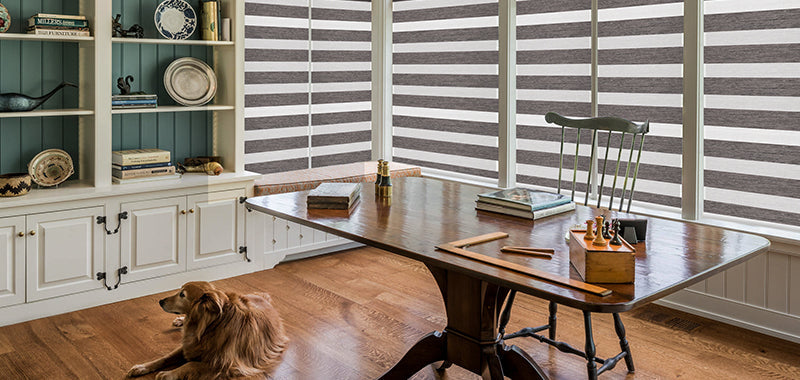
If you want total darkness, blackout is the way to go. For a softer, dimmed effect, room darkening works best. Prefer gentle light with a touch of privacy? Choose light filtering.
This guide breaks down the differences, pros and cons, and best use cases for each, so you can confidently choose the right shades for every room in your home.
Understanding the Core Differences Between Shade Types
Blackout Shades
Blackout shades block 100% of outside light. They're perfect for bedrooms, nurseries, or home theaters where total darkness is essential. These shades help improve sleep and block UV rays.
Room Darkening Shades
Room darkening shades reduce 85–95% of light, creating a soft, dimmed atmosphere without full darkness. They’re ideal for living rooms or spaces with TVs where glare reduction is key.
Light Filtering Shades
Light filtering shades allow natural light to pass through while diffusing it gently. They brighten a room while offering daytime privacy, making them great for kitchens, bathrooms, and home offices.
Related reading: What are light filtering curtains
Side-by-Side Comparison: Blackout vs Room Darkening vs Light Filtering
Light Control Level
- Blackout: Blocks all light.
- Room Darkening: Significantly dims, but doesn’t block completely.
- Light Filtering: Softens and diffuses incoming light.
Privacy During Day and Night
- Blackout: Full privacy at any time.
- Room Darkening: Good privacy, especially at night.
- Light Filtering: Daytime privacy only — silhouettes may be visible at night.
Best Room Applications
- Blackout: Bedrooms, nurseries, media rooms.
- Room Darkening: Living rooms, dens, home offices.
- Light Filtering: Kitchens, dining areas, sunrooms.
Pros and Cons
- Blackout: ✅ Blocks all light — ideal for sleeping. ❌ May feel too dark during the day.
- Room Darkening: ✅ Reduces glare while keeping some light. ❌ Doesn’t block all light.
- Light Filtering: ✅ Creates a bright, welcoming space. ❌ Limited privacy at night.
Style and Visual Impact
- Blackout: Sleek and functional, often thicker materials.
- Room Darkening: Balanced look between light control and softness.
- Light Filtering: Airy and elegant, available in more textures and tones.
Now that you know how they compare, let's match each type to your space.
Matching Shades to Your Room’s Purpose
Bedrooms and Nurseries
Choose blackout shades for maximum light control and privacy. Ideal for light-sensitive sleepers and street-facing windows.
Living Rooms and Open Spaces
Room darkening shades reduce glare without darkening the entire space — great for watching TV or creating a cozy atmosphere.
Home Offices and Media Rooms
Depending on screen placement and window direction, go with room darkening to control glare or light filtering for gentle natural light.
Kitchens and Dining Areas
Light filtering shades keep things bright and inviting while softening harsh sunlight.

Common Mistakes to Avoid When Choosing Shades
Mistaking Room Darkening for Blackout
Room darkening shades reduce light but do not block it completely. For true darkness, a blackout is required.
Ignoring Side Gaps
Even blackout shades may leak light at the edges if not paired with side channels or outside mounts.
Assuming Light Filtering Means Full Privacy
Light filtering shades can appear private by day but become see-through at night when indoor lights are on.
Smart Alternatives and Layering Options
Layering With Curtains or Liners
Pair light filtering shades with blackout curtains to enjoy bright days and dark nights in the same room.
Dual or Zebra Shades
Zebra shades combine sheer and solid panels, letting you alternate between filtered light and full privacy.
Dual shades feature two separate layers—typically a light-filtering shade and a blackout shade—that can be operated independently for versatile light management.
Motorized Options
Motorized blackout or room-darkening shades offer scheduled light control — ideal for hard-to-reach windows or automated routines.
Final Tips Before You Buy
Test Swatches in Your Actual Room
Lighting conditions and wall colors affect how a fabric looks and performs. Always try samples before committing.
Start With Function, Then Choose Style
Focus on what the room needs — blackout for sleep, filtering for light — then select a color and texture that suits your décor.
Don't Overlook Installation Style
Inside mounts offer a sleek, built-in look but may let in light at the edges. To enhance blackout performance, consider pairing them with side rail tracks or light blockers for a snug fit and minimal light gaps. SmartWings offers guidance on using side channels effectively. Outside mounts, on the other hand, are installed beyond the frame for broader light coverage. Explore SmartWings' detailed installation options and find the right style for your space.




